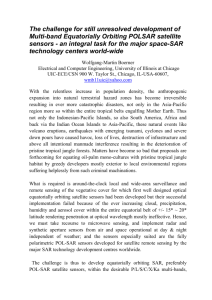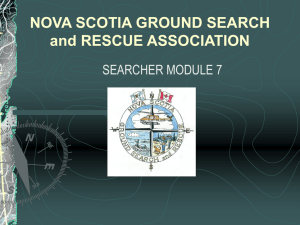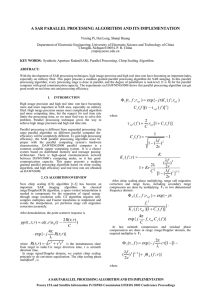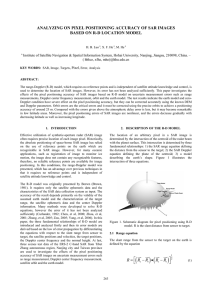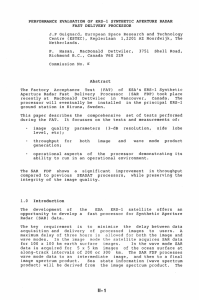Geometry & Radiometry/SAR processing Session
advertisement
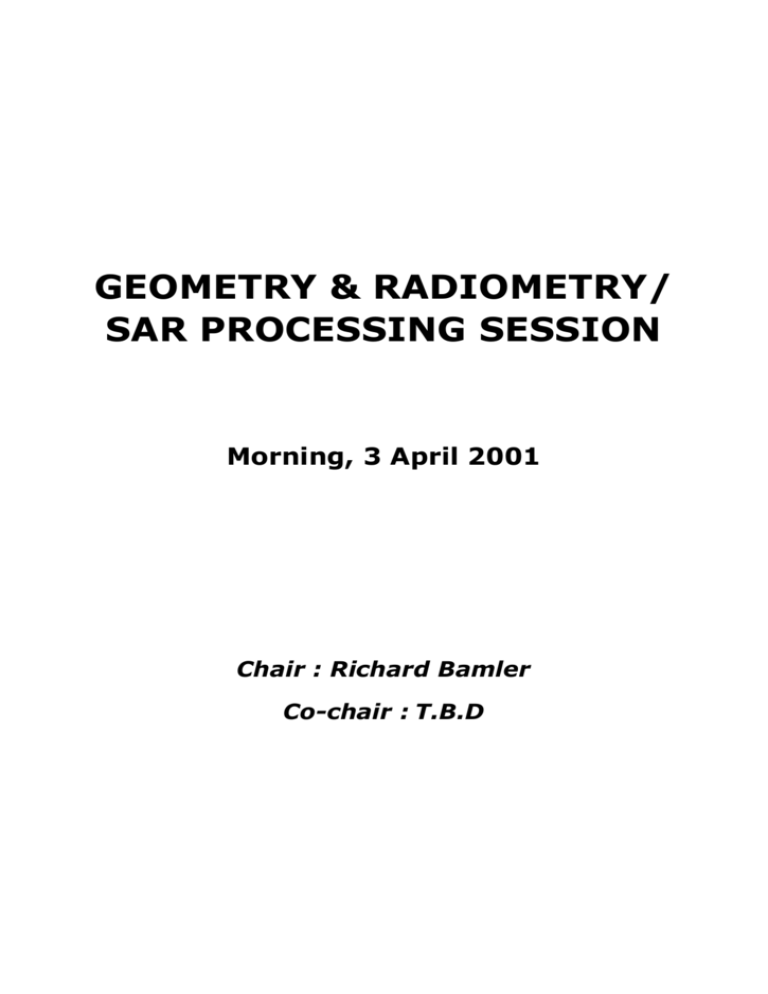
GEOMETRY & RADIOMETRY/ SAR PROCESSING SESSION Morning, 3 April 2001 Chair : Richard Bamler Co-chair : T.B.D Abstract Number : CEOS-SAR01-079 Preferences : Oral Session : Geometry & Radiometry Validation of Digital Terrain Models Processed from Spatial Imagery Applications in the Pyrennes (S France) Deffontaines B. (1), Rudant J.P. (2), Gobert S. (3), Laurencot T. (3), and Dubois-Fernandez P. (4) (1) ESA-CNRS, Universite Pierre et Marie Curie T.26-25, E1, Case 129, 4, place Jussieu F-75252 Paris Cedex 05, France, Email : benoit.deffontaines@lgs.jussieu.fr (2) Institut Francilien des Geosciences, Universite de Marne-La-Vallee Cite Descartes, France (3) Thomson-CSF/ISR Montrouge, France (4) CEGN Arcueil, France Within the following association ISR-THOMSON-SYSECA, CEGN, and Marne-la-Vallee University, we analysed and compared differents Digital Terrain Models (below DTMs) acquired from spatial images (SPOT-P, SAR-ERS1/2, RADARSAT) using the existing techniques (optical and radar stereo techniques, radargrammetry, radarclinometry and interferometry). Our aim is herein to compare the different resulting DTMs in order to select those highlighting topographic, geological and geomophological characteristics and minimizing artefacts on the same area. The application had been selected to various topographical, geomorphological, geological, climatological environments. Therefore the studied area present a contrasting relief and correponds to the northern Pyrenees (southern France) within a temperate climate showing three different test sites : The first one is a proximal alluvial glacis-cone in the almost flat Pyrenean foreland basin composed of alluvial conglomeratic low dipping deposits (Lannemezan cone); the second one corresponds to siliciclastic deposits folded and faulted, of the Pyrenean foothills close to the Boussens oil field ; the last one corresponds to the axial Pyrenean range (NE of the Pic du midi de Bigorre) where metamorphic rocks occur. Despite some low frequency and easily avoidable atmospheric artefacts, the DTMs extracted from interferograms techniques are of as high quality than the SPOT-P stereo technique especially in the flat lowland and the plateau. In the hilly area, DTMs extracted from SPOT stereo techniques are of better quality than interferometric ones. On the same areas, the radarsat (R3, R5, R7 and combinations) extracted DTM are generally of low and raw quality. To conclude, the geomorphological, geological characteristics are useful to establish the coherent parameters to test DTMs qualities. This study highlights the strategic importance to produce high quality DTMs from space imagery all over onshore areas. Abstract Number : CEOS-SAR01-021 Preferences : Oral Session : SAR Processing PC Satellite SAR Processor Ronald van Maarseveen Netherlands Organisation for Applied Scientific Research - Physics and Electronics Laboratory (TNO-FEL) Oude Waalsdorperweg 63, P.O. Box 96864, 2509 JG, The Hague, The Netherlands, Email : vanmaarseveen@fel.tno.nl This work created a prototype for a flexible fast multithreaded high precision PC Satellite SAR processor, which can operate on a network of low cost PC platforms. The network approach provides a scalable solution to divide the workload over multiple computers, thereby reducing the computation time. The processing software is set up in such a way that it can handle data from various satellite systems (eg. ERS/JERS/RADARSAT). Its primary purpose is to process any satellite raw SAR data into SAR slant- or ground-range image products. By applying clutter lock and auto focus techniques on the raw data, no satellite orbit data is needed, to derive range depended estimates for both the Doppler centroid frequency and the Doppler frequency rate. The software can choose out of three underlying SAR processors, of which each has their own primary purpose: 1. The Quick Look processor generates for minimal range migration data (or with a 10% faction of the azimuth replica filter on range migrated data) very fast a first impression overview image. 2. The Range Migration processor, which utilises a Range Doppler algorithm with a various interpolation range migration corrections, is best suited to run the auto focus sequences and will deliver depending on the range migration interpolation a good quality image. 3. The Chirp Scale processor, which uses a mathematical exact solution for range migration corrections, yields the best results for range migrated data. The quality of the resulting SAR image depends on the quality of the Doppler estimates. Initial testing is done on ERS and JERS data. Additional testing will be done using RADARSAT. An extension to process ENVISAT ASAR is foreseen. To give an indication on performance, one standard JERS scene is processed on a single dual Pentium 500 with 512MB memory: Clutter locking and auto focussing : 20 minutes Multi-look image generation (7looks with 50% overlap) : 30 minutes These processing times will be further reduced when using multiple computers.

